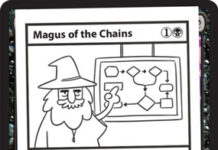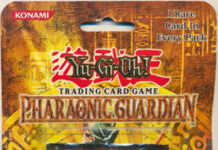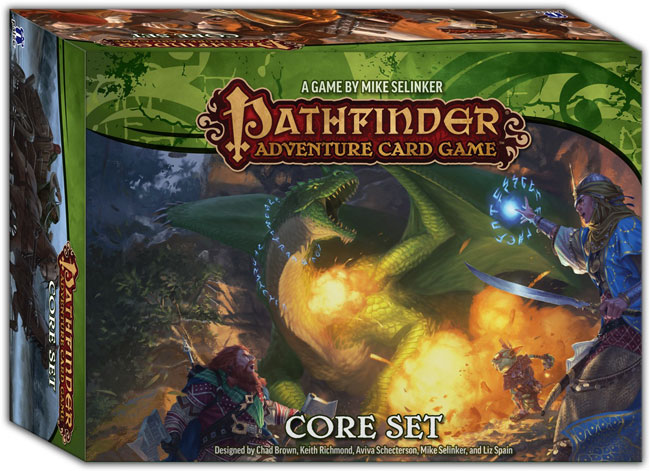
What is the Pathfinder Adventure Card Game?
The Pathfinder Adventure Card Game is a Cooperative Role-Playing “Card” Game based on the extremely popular Pathfinder Role-Playing Game (RPG). The Card Game was originally released in 2013, and designed for players that wanted the experiences of an RPG but didn’t have a Dungeon Master to run the show.
The original Pathfinder Adventure Card Game in 2013 was titled the “Rise of the Runelords Base Set”. More than 60 Add-Ons were created for that original base set that included: Class Decks, Adventure Decks, Equipment Decks, and more storylines for the game.
What is Pathfinder?
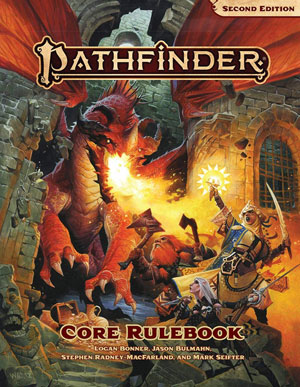
Pathfinder is a fantasy Role-Playing Game from Paizo Publishing. The Pathfinder RPG was first published in 2009. Pathfinder is somewhat based on the rules of Dungeons and Dragons (D&D) version 3.5 via D&D’s Open Game License.
Pathfinder tweaked D&D’s 3.5 rules a bit. Pathfinder introduced new character classes, like the Alchemist class. Spells, skills and fighting were also tweaked to the delight of many fans. In 2011, Pathfinder started outselling Dungeons and Dragons. In August 2019, Paizo released Pathfinder Second Edition.
What is the Pathfinder Adventure Card Game Core Set?
In 2019, Paizo Publishing decided to reboot the Pathfinder Adventure Card Game. It’s not quite a 2nd Edition, but some of the terminology on cards, and in the rulebook, has been cleaned-up to streamline game play. This is a perfect time for new players to jump into the game.
The Pathfinder Adventure Card Game (PACG) is a cooperative card game for 1 to 6 players. The Pathfinder Adventure Card Game gives players an opportunity to play the Pathfinder RPG without a Dungeon Master. The game is set in the exciting world of Pathfinder, and pits players against the same monsters, perils and traps they face in the standard RPG.
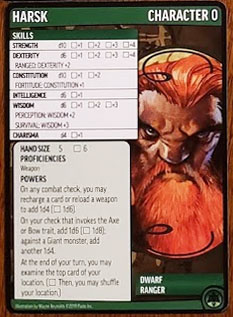
Each player starts with a unique character, like: Wizard, Alchemist, Ranger, Cleric, Bard, Rogue, Paladin, Fighter, , Barbarian, Sorcerer, Druid, Monk, etc.
Players also start with a unique deck to go along with their character. Players can make their own starting decks, or use a deck suggested by the Core Set Rulebook.
Players then explore a variety of locations and dungeons to overcome challenges. As the adventures continue, your characters add upgraded gear, items, weapons, spells and boost their attributes. Characters will get stronger powers, and you will need them to challenge increasingly more powerful threats.
Each time you play a session of Pathfinder, you will play one “Scenario”. You will play scenarios in a specified linear order. If you beat a scenario, you obtain loot. All players can then revise their decks making them stronger for the next scenario. You will then play the next scenario. Several linked scenarios are called an “Adventure”. And several linked Adventures are called an “Adventure Path”.
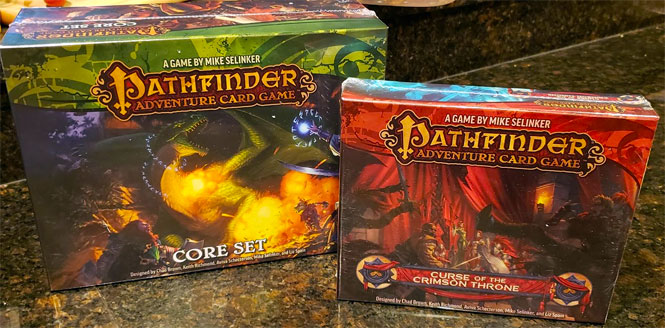
The Core Set, which we are reviewing today, has a new storyline – The Dragon’s Demand. This is nice for new and existing players. The Core Set has enough cards for 1 to 4 players to play cooperatively.
The “Curse of the Crimson Throne” (COTCT) Adventure Path expansion adds:
- 4 more character options to choose from
- Expands the maximum number of players to 6
- Adds 550 more cards
- and Adds more than 2 dozen more scenarios.
You don’t need this expansion initially though, unless you want to play The Dragon’s Demand Adventure with 5 or 6 players. We have a box opening for Curse of the Crimson Throne if you want to have a look inside. If your gaming group has 5 or 6 players, then you will need the expansion. If your gaming group has 4 or less players, then you can add the expansion after you finish the story in the Core Set.
What’s Inside the Box?
The Pathfinder Adventure Card Game: Core Set includes:
• 440 cards featuring a wide array of powerful weapons, magical spells, protective armors, versatile items, helpful allies, and divine blessings to help you face a host of vicious monsters, dangerous barriers, vile scourges, and perilous wildcards
• 12 character pawns, representing Pathfinder’s iconic character classes from the classic human cleric Kyra to the new goblin alchemist Fumbus
• 6 pawn bases
• A complete set of 5 polyhedral RPG dice
• 63 colorful tokens for tracking scourges and secondary objectives
• 24 dividers for organizing your cards
• 1 4-page Quick-Start Guide
• 1 32-page rulebook
• 1 24-page storybook featuring The Dragon’s Demand
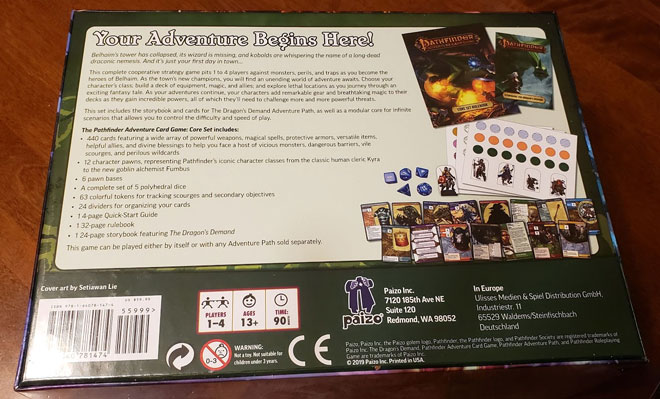
The box itself is pretty large at 12″ x 9″ x 4.5″.
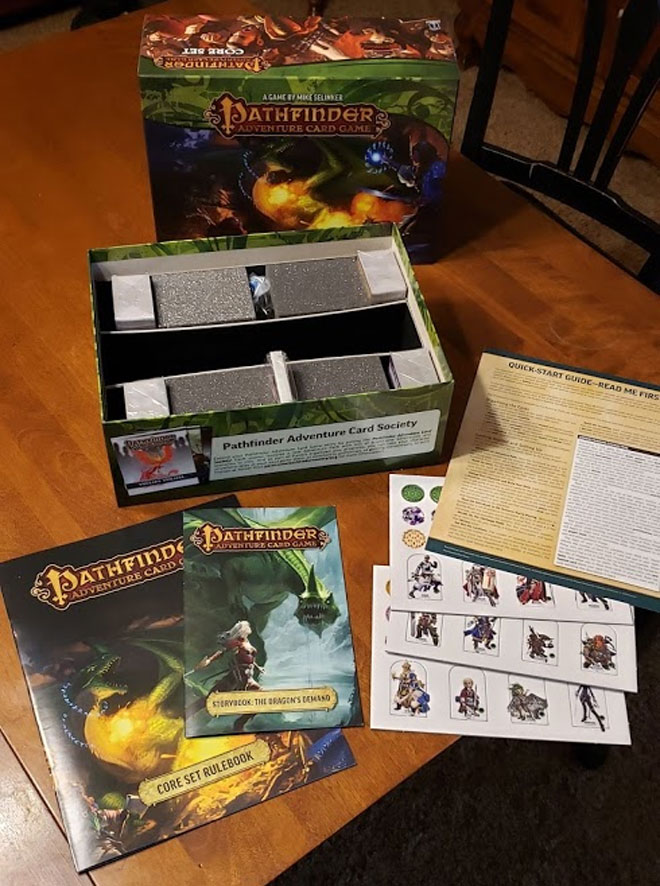
Everything is packed nicely inside. Once you remove the directions, storybook and punchouts, you notice the box is actually quite empty. The box is nicely designed to hold future expansions, with 3 slots, dividers and foam blocks.
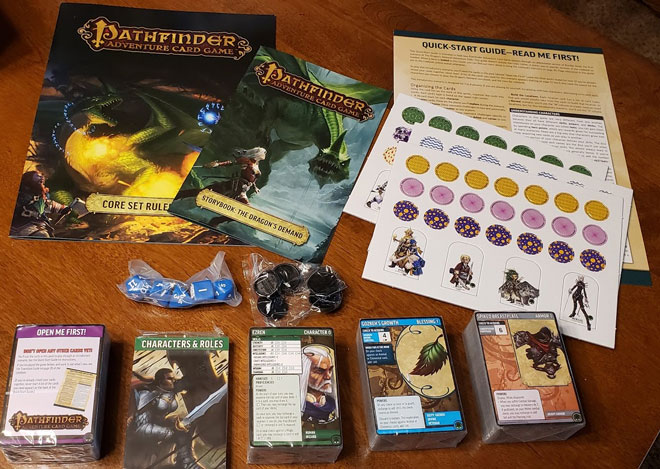
In additions to the dice and pawn tokens, there are 5 packages of cards. The “Open Me First” package has 4 premade decks for you to play a quick tutorial scenario. The Characters & Role package is a package of dividers for the box. The other 3 packages are all the cards you need to play through The Dragon’s Demand Storyline.
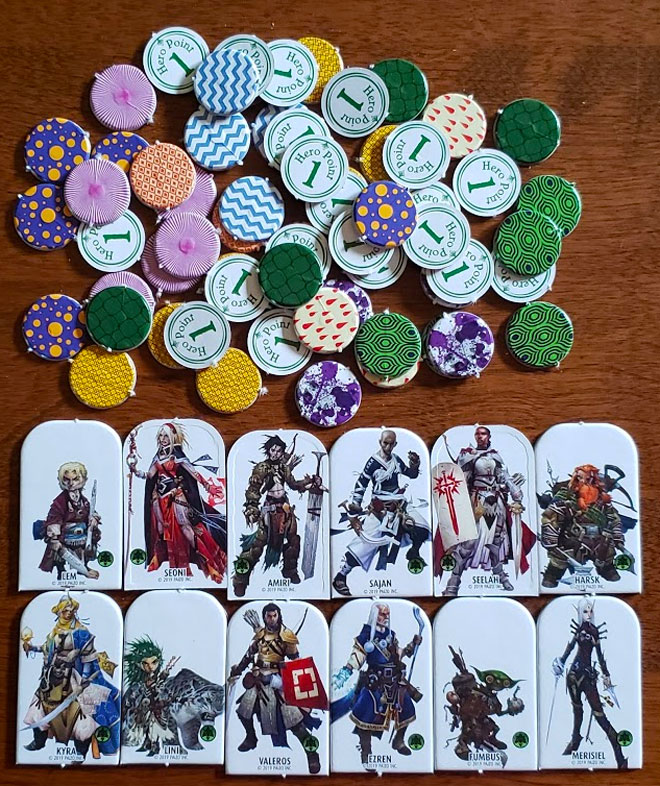
Above are the 12 Player Tokens that come in the Core Set. They are standard cardboard punch outs that players will use to show which location they are visiting. Below are the player tokens on their bases.

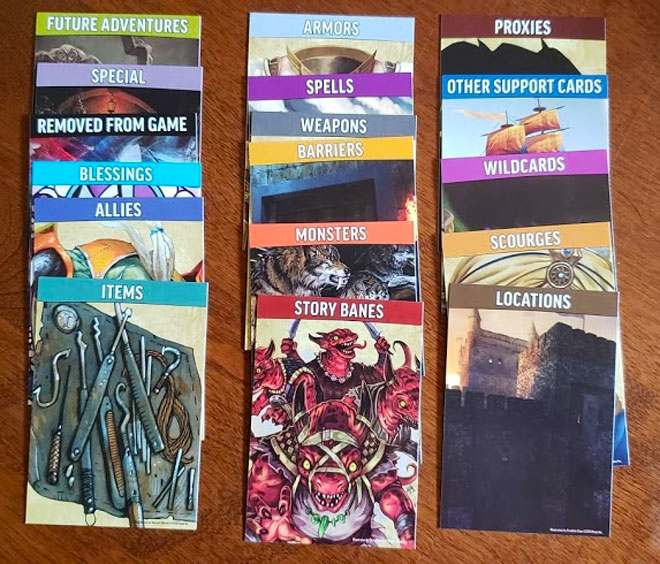
The Core Set includes plenty of dividers to easily keep track of all your cards in the box. There is also one full set of RPG dice. This game does not use 20 sided dice.

Character Cards:
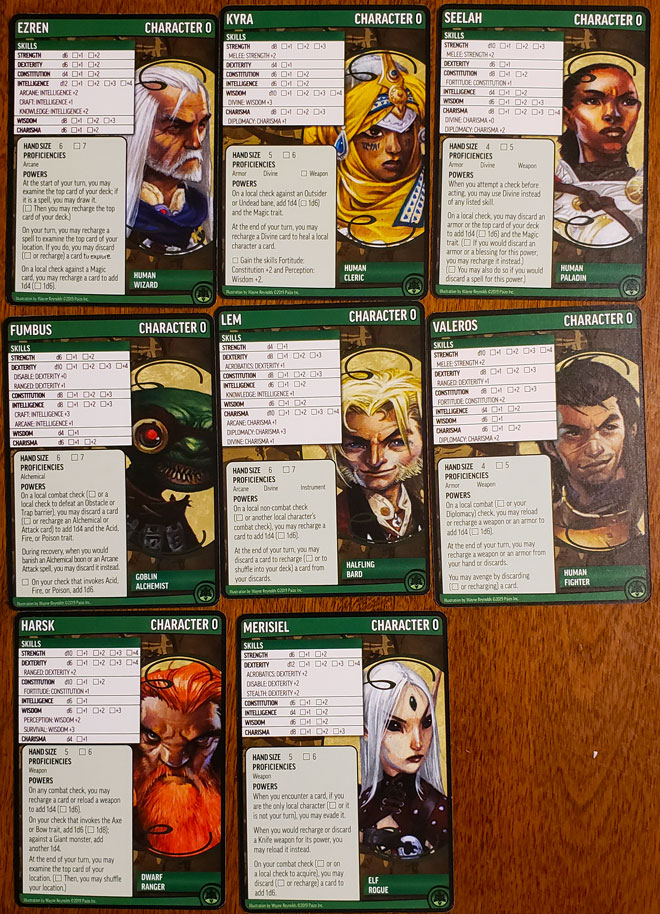
Suggested Starting Characters for the Tutorial / Quick-Start Guide:
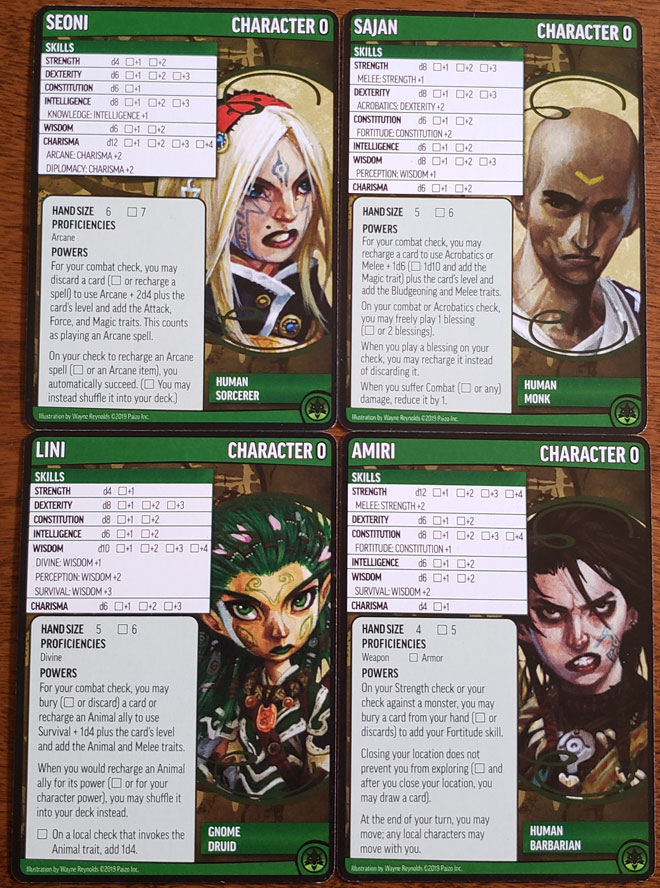
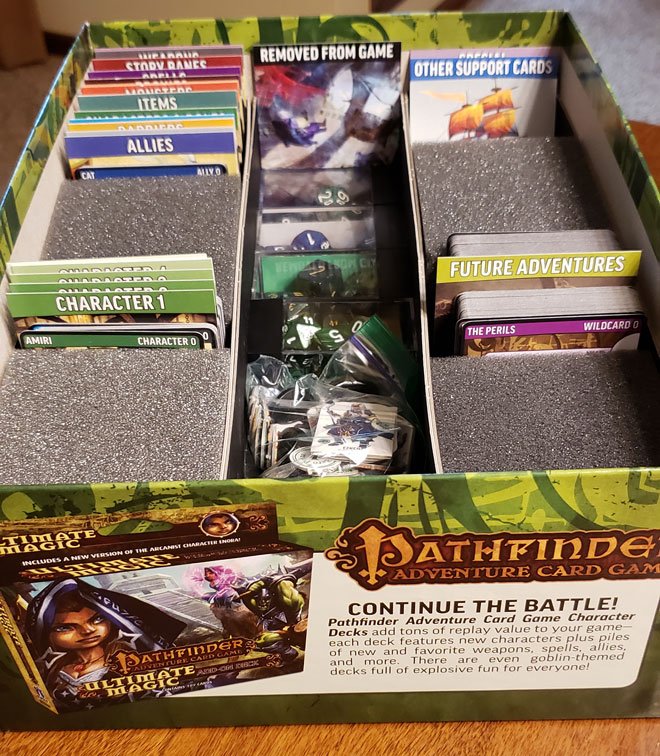
The Box Core Set Box acts as a storage box, and easily holds all the game’s contents, my extra dice, and plenty of room for future expansions.
Gameplay
My gaming group for the playthrough was 4 players. Paizo nicely sets up the very first Adventure Scenario for you: “The Dragon’s Demand – Rumble Road”. Four characters and their suggested starting decks are already pre-built … as are the villains, the locations and the location decks. So our first playthrough was with:
- Seoni – Human Sorcerer
- Lini – Gnome Druid
- Amiri – Human Barbarian
- Sajan – Human Monk
One of our players read the Scenario aloud as suggested in the Storybook, and we dove into the adventure. I’m not going to go into too much detail explaining game play. There are two things that really helped me understand the rules:
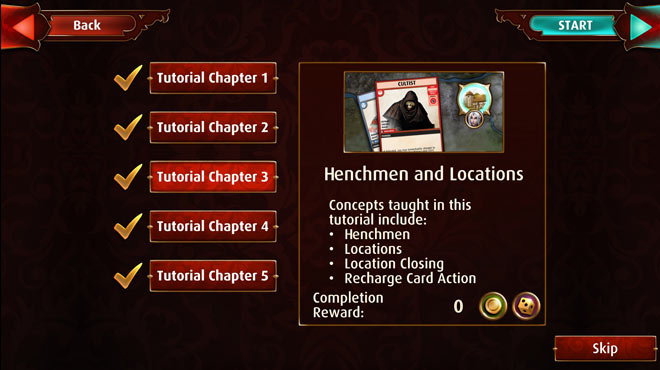
- The FREE Pathfinder Adventures App for Apple and Google devices. This is a digital adaptation of the game. There is an excellent tutorial inside the app that walks you through the rules through a series of puzzles you must solve. The app is excellent. You can play the app for awhile for free, but it will cost you a few bucks to continue to play more and more adventures, and buy characters you to use.
2. YouTube Videos – There are several YouTube videos that show you in detail how to play.
Basically though, there are several locations that players move their character tokens to, and players must explore those locations until they find the boss/henchmen or a boss monster. You have to defeat the bosses and or monsters at each location to close the locations to keep the main boss from running to another hideout, and you have to finally defeat the main boss.
Players’ decks house their weapons, armor, spells, items, blessings and Allies. Players’ decks are also their life points. If a player’s character burns through his or her entire deck during gameplay, their character dies! And if you play by the rules, their character really dies the true death – Permanent Death! That player is supposed to roll a new character, who will start with weaker gear than your previous character probably had. OUCH!
Luckily (not quite skillfully), all our players’ characters have survived our gameplay so far. Players use the weapons, spells and items in their character decks to attack monsters at each location. Each character has different skills for attacking: Mages use spells; Warriors use hand weapons; Rangers (Hunters) use bows; Etc.
Each player takes their turn, and then play passes to the next player. Players can hand each other gear they’ve acquired if they are at the same location. Players can also heal and attack other player’s monsters if their cards allow it.
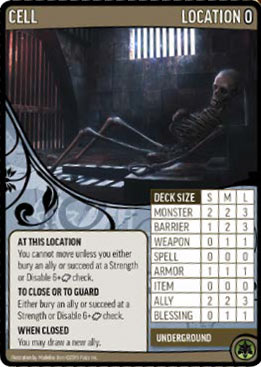 Scenarios are timed, but not using a real clock. You use cards as an hourglass. Each time a player takes a turn, one card is basically removed from the hourglass. Each scenario gives you the opportunity to play a short game, a standard/medium length game, or a long game. You will have more time (more cards in the hourglass) in a longer game. Then, each location will tell you how many cards are hiding in each location. As you can see here (Cell Location Image), you will find less monsters in a short game, but there is also less of a chance of finding weapons in a short game.
Scenarios are timed, but not using a real clock. You use cards as an hourglass. Each time a player takes a turn, one card is basically removed from the hourglass. Each scenario gives you the opportunity to play a short game, a standard/medium length game, or a long game. You will have more time (more cards in the hourglass) in a longer game. Then, each location will tell you how many cards are hiding in each location. As you can see here (Cell Location Image), you will find less monsters in a short game, but there is also less of a chance of finding weapons in a short game.
I must say, even though a couple of us had played Dungeons and Dragons many years ago, the terms were a bit difficult to grasp. We really bumbled our way through our first scenario. So many terms likes: “Recharge, Reload, Recover” are used often during gameplay, and sound like they might do similar things, when they do not! There are like 115 terms in the glossary of the rulebook and you might be looking them all up at one time or another.
Likes, Dislikes and Final Thoughts
Likes
I can see this game being very fun for people to play when they don’t have a Dungeon Master. It takes a very special person to be a good Dungeon Master (DM), and a lot of people don’t want to DM. DM’ing requires a good investment in time preparing adventures for your group. Pathfinder Adventures Card Game can be a great game if you have a group (of up to 6 players) that can get together regularly and want to solve an adventure.
Heck, this would be a great puzzle type game for players that love to play solo. I’ve seen videos of people that play through scenarios solo online.
The Game is actually very challenging. Your turns are not mindless. If you all want to live, you have to discuss things and work on a plan together. You might be able to help another player defeat a boss, even when it’s your turn.
I think the box acting as a storage system for future expansions is a fantastic idea. It reminds of the “Bigger Geekier” storage box for Smash Up. As more cards and expansions are released, you can simply remove the foam cushions and add those expansions into the Core Set Box.
I like the fact that you get complete Adventure Path in this core set. The Dragon’s Demand Storyline includes 3 Adventures and 10 Scenarios. As I understand it, the original Edition Core Set (2013) only included the beginning of the Rise of the Runelords Adventure Path, not a complete campaign.
As a total newbie to the Pathfinder Adventure Card Game, I appreciate the fact that Paizo included a Quick Start Guide with 4 premade decks. The 4 page Quick Start Guide is super helpful to newbies.
I also love the fact that there are plenty of characters, as well as other roles the character could fill. There are 12 different characters in the starter to choose from, and each character has a role to choose. For example Harsk is a Ranger, and he could also be a Warden or a Dragonhunter.
Paizo is a fantastic company and they treat their fans well. You can see this through their website and at Conventions. Some of the happiest players at conventions hang around the Paizo booth. The Paizo website is fantastic. It has rules, downloads, and a forum for asking questions. They have also have an online store where you can buy add-ons for your games.
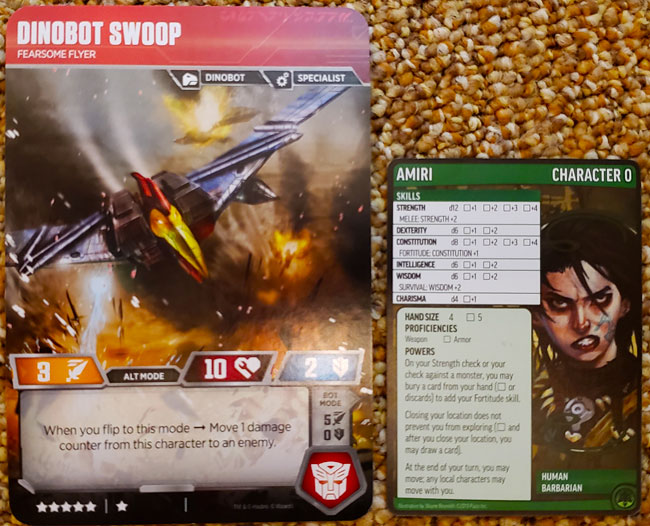
Dislikes
The font size on the cards is really small. I wish Paizo had used larger character cards and a larger font like Wizards of the Coast does with their Transformer Character Cards. The cards are just difficult to read at times. Unless you have the eyes of an eagle, players will have to pick up and hold the cards closer to their faces in order to read their character powers and/or make checks on their turns.
This can be a tough game to learn. The rulebook is 32 pages long, and a detailed read. Here is a link to Paizo’s Download Page. You can download a lot of good stuff here, and have a look at the rulebook for yourself. The Rulebook is well-written and explains everything. But it can be a overwhelming to new players. I wholeheartedly recommend that newbies download the free Pathfinder Adventure Card Game App to their phones or tablets and take the free tutorials built into the app. These tutorials will help tremendously in learning the game. It might also serve you well to learn the game at a convention like GenCon, or at a local game store.
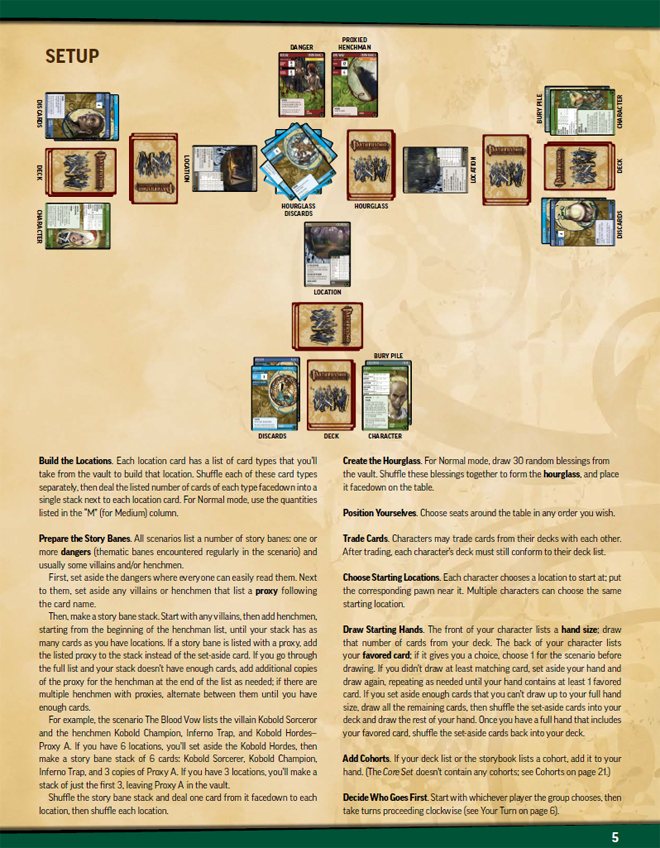
The player tokens are generic cardboard tokens, but they serve their purpose. If you get attached to a particular character, you could always buy miniatures of your heroes online.
The artwork on the cards is not really my preferred style, but it won’t bother me during gameplay to be honest. Art is very subjective, and some players might love it. Once you get into the game, you don’t even think about card art anymore anyway.
There is only one set of generic blue RPG dice in the Core Set. For gameplay, it’s easier if everyone has their own set of Gaming Dice. If you get to playing with a big group, just ask everyone to buy & bring their own set of dice. In RPG’s, it seems like many players love to collect their own sets of appealing dice anyway.
It might be a little tough to incorporate old 1st Edition character packs into this 2nd Edition of the Core Set. There is a transition guide in the rulebook, but you might be better off starting from scratch with the new core set and it’s expansions.

Final Thoughts
The retail price of the Pathfinder Adventure Card Game: Core Set is $59.99. That seems reasonable for this adventure. You get a nice storage box, 12 different playable characters, 440 cards, and a full-blown Adventure.
The game seems perfect for a small group of friends that want to get together regularly, and play through a cooperative gaming campaign. And if you have more than 4 players you can snag the Curse of the Crimson Throne expansion and play with up to 6 players. And you will also get 550 more cards and a second Adventure.
The great part of this game is that no one has to Dungeon Master! As I said before, Good Dungeon Masters can be hard to find, and that’s why they make games like the Pathfinder Adventure Card Game.
For Players who regular play Trading Card Games, or Role-Playing Games, this will not be too tough to comprehend, learn and play. The game is definitely fun and challenging. I almost consider this to be a group puzzle solving game – each scenario is like an escape room.
This is not a light game. This is not a game for families with young kids – not because of violence, but because if difficulty. The box say ages 13+, and that basically puts you in high school+.
PACG seems perfect for college gamers and beyond. I wish this game was around in the 80’s when I was in college. Although Strat-O-Matic Baseball wasn’t all that bad.


